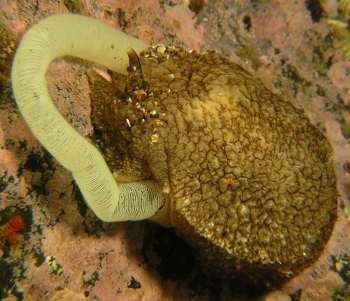
Pleurobranchaea cf. japonica
Order: NOTASPIDEA
Superfamily: PLEUROBRANCHOIDEA
Family: Pleurobranchidae
PHOTO
Animal with egg ribbon. Sasu Harbor, Jeju Island, Sth Korea. Depth: 5 m. Length: about 60mm. 27 June 2004. Sandy bottom with Rock. Photographer: Dong Jin Jwa
Pleurobranchaea japonica Thiele, 1925 is considered by Marcus & Gosliner (1984) to be unidentifiable from Thiele's original description. They suspect it is possibly a synonym of P. maculata. The photo here is of an animal from Sth Korea identified by Dong Bum Koh as P. japonica.
-
Marcus, Ev. & Gosliner,T.M. (1984) Review of the family Pleurobranchaeidae (Mollusca, Opisthobranchia). Annals of the South African Museum, 93: 1-52, Figs 1-25.
Rudman, W.B., 2005 (April 23) Pleurobranchaea cf. japonica [In] Sea Slug Forum. Australian Museum, Sydney. Available from http://www.seaslugforum.net/find/pleucfjapo
Related messages
Re: egg laying in Pleurobranchaea
April 27, 2005
From: Dong Bum Koh

Dear Bill,
Concerning your question about my earlier message [#13638]. I rechecked my films but it's not a reversed image. And attached is a new photo of the same animal in just a little different position. It also looks like the egg ribbon is from the left side of animal.
I also include two photos [B,C], you can use as evidence that the egg ribbon is being extruded from the right side of animal. Could you explain to me what is truth, Right or Left?
Best regards,
Dong Bum Koh
drkoh@seasee.co.kr

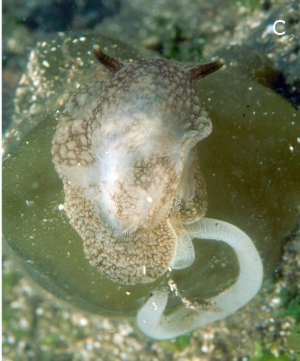
Dear Koh,
Sorry if I wasn't clear in my earlier comments. What I meant was that, at first, I thought your photo was reversed because the egg mass seems to be be coming out of the left side of the animal, but as your Photo A here shows clearly, the egg ribbon is under the animal. The animal is either crawling over the egg ribbon, or using the sole of its foot to manipulate the egg ribbon into position. Many dorid nudibranchs, and sacoglossans, use their foot to manipulate the egg ribbon into a spiral and to fasten it to the substrate, after it has been extruded from the genital opening. Species of Pleurobranchaea don't usually have a regular spiral, but certainly the egg ribbon [or tube] needs to be fastened to the substrate and it seems the foot is used to hold it down while the mucous 'glue' dries.
Either way, the egg ribbon is definitely being extruded from the right side. Thanks for these interesting photos.
Best wishes,
Bill Rudman
Pleurobranchaea cf. japonica - mating behavior [3]
April 26, 2005
From: Dong Bum Koh
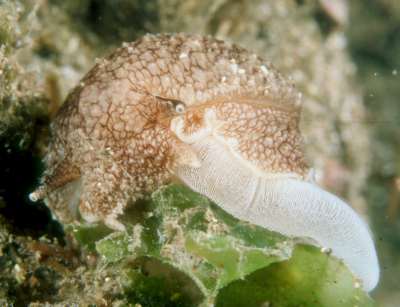
Dear Bill,
Concerning the mating behavior of Pleurobranchaea cf. japonica. Here are a set of photos for your Forum, showing egg laying. [see also #13642, #13643.]
Locality: Sasu Harbour, nth coast of Jeju Island, Sth Korea. Depth: 5 m. Length: about 65 mm. 27 June 2004. Sandy bottom with Rock. Photographer: Byung Ro Youn
Best regards,
Dong Bum Koh
drkoh@seasee.co.kr
D. B. Koh, 2005 (Apr 26) Pleurobranchaea cf. japonica - mating behavior [3]. [Message in] Sea Slug Forum. Australian Museum, Sydney. Available from http://www.seaslugforum.net/find/13638
Thanks Koh,
I at first thought that this photo was reversed, as it seems to show the egg ribbon being extruded from the left side of the animal, which would have been wrong, because the reproductive openings are on the right side, just in front of the gill.
However, as the close-up shows, the egg ribbon is passing out from under the foot. Quite a few opisthobranchs seem to manipulate the egg ribbon with the foot, helping to shape it and attach it at least in some dorids, and it seems from this photo that Pleurobranchaea does something similar. This is a very valuable observation.
Best wishes,
Bill Rudman
Pleurobranchaea cf. japonica - mating behavior [1]
April 26, 2005
From: Dong Bum Koh
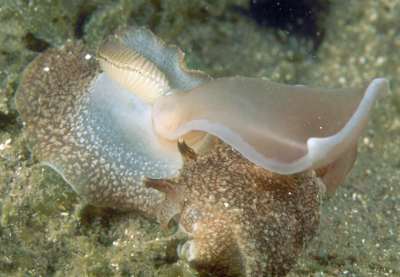
Dear Bill,
Concerning the mating behavior of Pleurobranchaea cf. japonica.
Here are a series of photos for your Forum, showing mating behaviour. Mating behavior was very active and spectacular.
Locality: Sasu Harbour, nth coast of Jeju Island, Sth Korea. Depth: 5 m. Length: about 65 mm. 27 June 2004. Sandy bottom with Rock. Photographer: Byung Ro Youn
Best regards,
Dong Bum Koh
drkoh@seasee.co.kr
D. B. Koh, 2005 (Apr 26) Pleurobranchaea cf. japonica - mating behavior [1]. [Message in] Sea Slug Forum. Australian Museum, Sydney. Available from http://www.seaslugforum.net/find/13642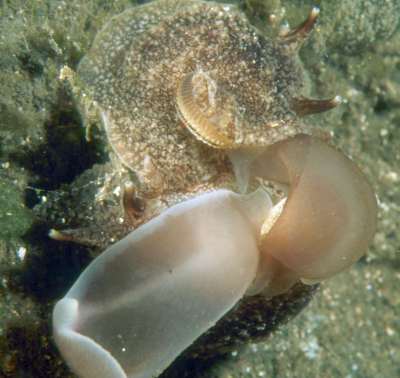
Dear Koh,
Thanks for these wonderful photos. I have split them into 3 messages [see #13643, #13638 ] so I can display them at a larger size than normal. The two photos in this message show 2 animals, each with their large plate-like penis fully extended. The actual penial papilla is the small conical structure at the outer corner. You can also see the seminal duct as a whitish line running diagonally through the almost transparent tissue of the penis. Like all opisthobranchs, these animals are hermaphrodites. The female opening is at the base of the penis just alongside the anterior edge of the large gill which can be easily seen in both these photos.
I have no idea why the penis is so large.
Best wishes,
Bill Rudman
Pleurobranchaea cf. japonica - mating behavior (2)
April 26, 2005
From: Dong Bum Koh
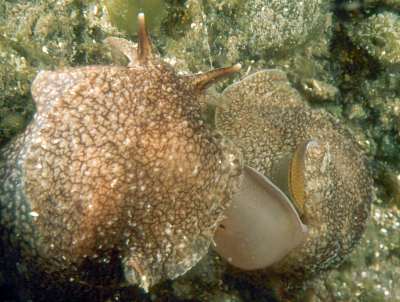
Dear Bill,
Concerning the mating behavior of Pleurobranchaea cf. japonica.
Here are the second set of photos for your Forum, showing mating behaviour. [see also #13642, #13638]
Locality: Sasu Harbour, nth coast of Jeju Island, Sth Korea. Depth: 5 m. Length: about 65 mm. 27 June 2004. Sandy bottom with Rock. Photographer: Byung Ro Youn
Best regards,
Dong Bum Koh
drkoh@seasee.co.kr
D. B. Koh, 2005 (Apr 26) Pleurobranchaea cf. japonica - mating behavior (2). [Message in] Sea Slug Forum. Australian Museum, Sydney. Available from http://www.seaslugforum.net/find/13643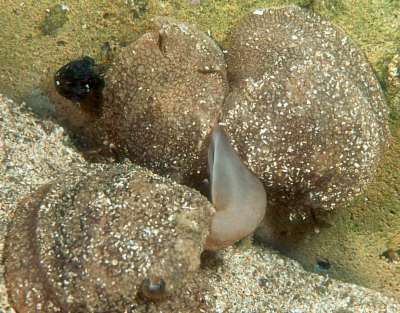
Dear Koh,
Although I can apparently see only one penis in each of these photos, I assume the second is hidden behind the first, and both animals are exchanging sperm
Best wishes,
Bill Rudman
Pleurobranchaea japonica laying eggs
April 25, 2005
From: Dong Bum Koh

Dear Bill,
Here is a photo of Pleurobranchaea japonica laying an egg ribbon to accompany my message [#13627] on Favorinus mirabilis from Jeju island eating eggs of P. japonica.
Locality: Sasu Harbor, Jeju Island, Sth Korea. Depth: 5 m. Length: about 60mm. 27 June.2004. Sandy bottom with Rock. Photographer: Dong Jin Jwa
Best regards,
Dong Bum Koh
drkoh@seasee.co.kr
Koh, D.B., 2005 (Apr 25) Pleurobranchaea japonica laying eggs. [Message in] Sea Slug Forum. Australian Museum, Sydney. Available from http://www.seaslugforum.net/find/13628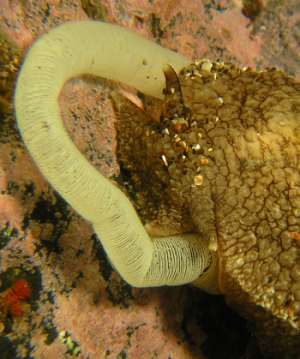
Dear Koh,
Thanks for this photo which shows this Pleurobranchaea with it typically shaped egg ribbon. I am interested in your identification as P. japonica Thiele, 1925 as Marcus & Gosliner (1984) consider that the species is unidentifiable from Thiele's original description. They suspect P. japonica is possibly a synonym of P. maculata. I guess the safest procedure is to place you species as Pleurobranchaea cf. japonica until the taxonomy of these animals is clearer.
Best wishes,
Bill Rudman
